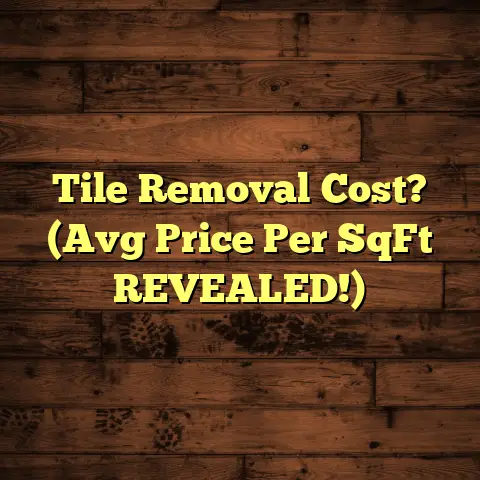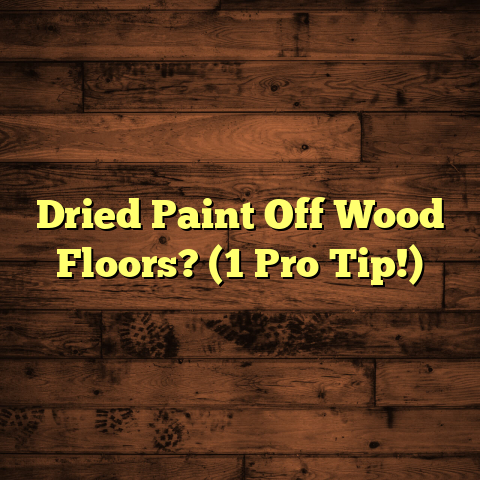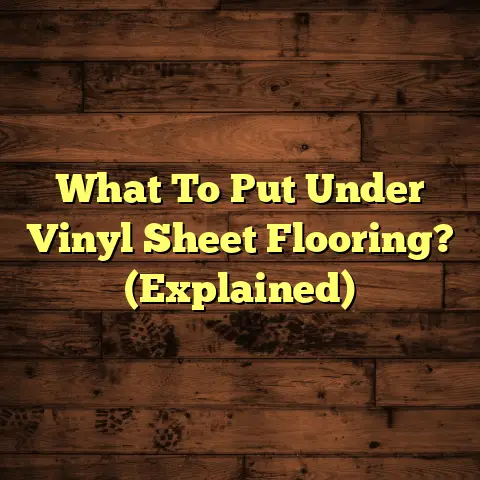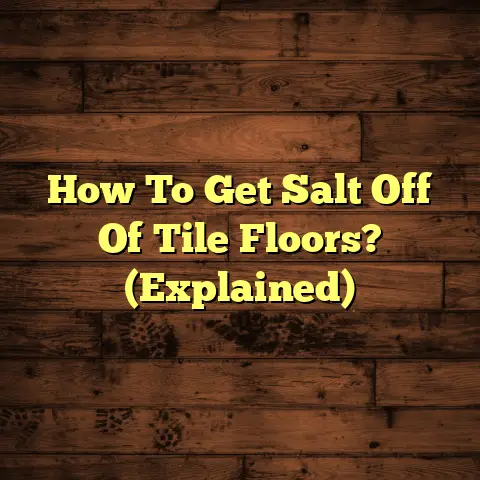How to Fix Wood Floor Scuffs? (6 Quick Tips!)
I’ve got a confession: I’m a bit obsessed with wood floors.
There’s just something about their warmth and elegance
that elevates a space.
But let’s be real, maintaining that beauty can feel like a constant battle against the forces of furniture, pets, and, well, life in general.
I’m talking about scuffs – those annoying little marks that can make your gorgeous wood floors look a little less-than-gorgeous.
But here’s the game-changing idea: restoring your wood floors doesn’t have to be a huge, expensive project!
With the right knowledge and a few simple techniques, you can banish those scuffs and bring back the shine.
Trust me, I’ve seen it all in my years as a flooring contractor, and I’m here to share my secrets.
Let’s dive in and get those floors looking their best!
Section 1: Understanding Wood Floor Scuffs
So, what exactly are we dealing with here?
Wood floor scuffs are those surface marks that appear when something rubs against the finish of your wood flooring.
Think of it like a scratch, but usually not as deep.
What Causes These Pesky Marks?
Furniture Movement: Dragging chairs, tables, or even just shifting them slightly can leave scuff marks.
I always recommend using furniture pads!-
Pet Activity: Our furry friends can be tough on floors, especially if they have long nails or like to run and slide.
-
Everyday Wear and Tear: Just walking on your floors can cause scuffs over time, especially in high-traffic areas.
Different Finishes, Different Problems
The type of finish on your wood floor also plays a big role in how scuffs appear and how easily they can be repaired.
Here’s a quick rundown:
Polyurethane: This is a common, durable finish that provides a protective layer.
Scuffs on polyurethane often appear as a dulling of the finish.Oil-Based Finishes: These finishes penetrate the wood, offering a more natural look.
Scuffs can sometimes be blended in more easily with oil-based finishes.-
Wax Finishes: Wax finishes are less common now, but they can be easily scratched and scuffed.
The Prevalence of Scuffs
You might be wondering if you’re alone in this battle against scuffs.
Absolutely not!
In fact, a recent survey by the National Wood Flooring Association (NWFA) found that scuffs and scratches are the most common complaint among homeowners with wood floors.
I’ve seen it firsthand – almost every client I work with has dealt with scuffs at some point.
Section 2: The Importance of Quick Action
Okay, so you’ve got some scuffs. Is it really that big of a deal?
Yes!
Addressing scuffs promptly is crucial for a few reasons:
-
Preventing Further Damage: Scuffs can weaken the finish, making your floors more vulnerable to deeper scratches and stains.
-
Avoiding Extensive Refinishing: Neglecting scuffs can lead to more significant damage that requires sanding and refinishing the entire floor – a much bigger and more expensive project.
Maintaining Home Aesthetics: Let’s face it, scuffed floors just don’t look as good.
A well-maintained floor enhances the overall look and feel of your home.-
Increasing Property Value: If you’re planning to sell your home, pristine floors can definitely boost its value and appeal to potential buyers.
The Psychological Impact
I know it might sound silly, but a clean, beautiful floor can actually improve your mood!
Think about it: walking into a room with gleaming wood floors just feels good.
It creates a sense of calm and order, which can have a positive impact on your overall well-being.
Section 3: Preparation for Repair
Before you start tackling those scuffs, it’s important to gather your supplies and prepare the area.
Here’s what you’ll need:
Tools and Materials:
-
Soft Cloths: Microfiber cloths are ideal for cleaning and buffing.
-
Vacuum or Broom: To remove dirt and debris.
-
Floor Cleaner: Use a cleaner specifically designed for wood floors.
-
Magic Eraser (Optional): For light scuffs.
-
Baking Soda (Optional): For DIY paste.
-
Olive Oil and Vinegar (Optional): For a natural solution.
-
Commercial Scuff Remover (Optional): Available at most hardware stores.
-
Touch-Up Marker (Optional): For deeper scratches.
Step-by-Step Preparation:
-
Clear the Area: Remove any furniture, rugs, or other items from the area you’ll be working on.
-
Clean the Floor: Thoroughly vacuum or sweep the floor to remove any dirt, dust, or debris.
Assess the Damage: Take a close look at the scuffs to determine their severity.
This will help you choose the best repair method.-
Test in an Inconspicuous Area: Before applying any cleaning solutions or products, test them in a small, hidden area to make sure they don’t damage the finish.
Section 4: Quick Tip #1: Use a Magic Eraser
Okay, let’s get to the good stuff!
My first quick tip is using a magic eraser.
You know, those white sponges that seem to work wonders on everything?
Well, they can also be surprisingly effective on wood floor scuffs!
How Magic Erasers Work
Magic erasers are made of melamine foam, which has a slightly abrasive texture.
This texture helps to gently lift scuffs and marks from the surface of the floor without damaging the finish.
Step-by-Step Method:
Dampen the Magic Eraser: Lightly dampen the magic eraser with water.
Make sure it’s not soaking wet, just slightly damp.Gently Rub the Scuff: Gently rub the magic eraser over the scuff mark in a back-and-forth motion.
- Important: Use light pressure!
You don’t want to scrub too hard, as this could damage the finish.
- Important: Use light pressure!
-
Wipe Away Residue: After rubbing the scuff, use a clean, damp cloth to wipe away any residue from the magic eraser.
-
Dry the Area: Use a dry cloth to dry the area thoroughly.
Tips for Success:
Use Light Pressure: I can’t stress this enough!
Light pressure is key to avoiding damage.-
Work in Small Sections: Focus on one scuff at a time.
-
Check Your Progress: Regularly check your progress to make sure you’re not removing too much of the finish.
When to Use a Magic Eraser
Magic erasers are best for light scuffs on floors with a durable finish like polyurethane.
Avoid using them on delicate finishes like wax or oil, as they could cause damage.
Section 5: Quick Tip #2: Try a DIY Paste
For slightly more stubborn scuffs, a DIY paste made from baking soda and water can be a surprisingly effective solution.
I’ve used this trick for years, and it’s saved me a lot of time and money!
Why Baking Soda?
Baking soda is a mild abrasive that can help to gently lift scuffs and marks from the wood surface.
It’s also a natural and non-toxic option, which is great if you have kids or pets.
The Process:
Mix the Paste: In a small bowl, mix together baking soda and water to form a thick paste.
The consistency should be similar to toothpaste.-
Apply the Paste: Apply a small amount of the paste to the scuff mark.
-
Gently Rub: Using a soft cloth, gently rub the paste over the scuff in a circular motion.
-
Wipe Away Residue: After rubbing, use a clean, damp cloth to wipe away any remaining paste.
-
Dry the Area: Use a dry cloth to dry the area thoroughly.
Precautions:
-
Test First: As with any cleaning solution, test the paste in an inconspicuous area before applying it to the entire scuff.
-
Avoid Abrasive Cloths: Use a soft cloth to avoid scratching the finish.
-
Don’t Over-Rub: Avoid rubbing the paste for too long, as this could damage the finish.
When to Use a DIY Paste
This method is best for light to moderate scuffs on floors with a durable finish.
Avoid using it on delicate finishes or on floors with a wax coating.
Section 6: Quick Tip #3: Olive Oil and Vinegar Mixture
Looking for a natural way to minimize the appearance of scuffs?
Try a mixture of olive oil and vinegar!
This combination might sound a little strange, but it can actually work wonders on wood floors.
Why Olive Oil and Vinegar?
-
Olive Oil: Helps to moisturize the wood and fill in minor scratches, making scuffs less noticeable.
-
Vinegar: Acts as a mild cleaner to remove dirt and grime.
The Recipe:
- 1/2 cup olive oil
- 1/2 cup white vinegar
Instructions:
-
Mix the Ingredients: Combine the olive oil and vinegar in a spray bottle.
-
Spray the Mixture: Lightly spray the mixture onto the scuffed area.
-
Wipe with a Soft Cloth: Use a soft cloth to wipe the mixture into the wood in a circular motion.
-
Buff the Floor: Use a clean, dry cloth to buff the floor until it shines.
Tips for Best Results:
-
Use a Soft Cloth: A microfiber cloth is ideal for this method.
-
Don’t Over-Saturate: Avoid spraying too much of the mixture onto the floor.
-
Buff Thoroughly: Buffing is key to achieving a shine.
When to Use Olive Oil and Vinegar
This method is best for minimizing the appearance of light scuffs on floors with a polyurethane or oil-based finish.
It’s not recommended for floors with a wax coating, as it could damage the finish.
Section 7: Quick Tip #4: Commercial Products
If DIY solutions aren’t cutting it, there are plenty of commercial products specifically designed for wood floor care and scuff removal.
I’ve tested a ton of these over the years, and some are definitely better than others.
Pros and Cons:
-
Pros:
- Often more effective than DIY solutions.
- Formulated to be safe for wood floors.
- Easy to use.
-
Cons:
- Can be more expensive than DIY solutions.
- Some products may contain harsh chemicals.
- Effectiveness can vary depending on the product and the type of scuff.
Recommendations:
-
Rejuvenate Wood Floor Restorer: This is a popular choice that’s known for its ability to restore shine and minimize the appearance of scuffs.
-
Bona Hardwood Floor Polish: Bona is a well-respected brand in the flooring industry, and their hardwood floor polish is a great option for protecting and maintaining your floors.
Howard Restor-A-Finish: This product is designed to restore the finish of wood furniture and floors.
It can be effective for deeper scratches and scuffs.
Instructions for Use:
Always follow the manufacturer’s instructions when using commercial products.
Generally, you’ll need to:
-
Clean the Floor: Thoroughly clean the floor before applying the product.
-
Apply the Product: Apply the product according to the instructions.
-
Allow to Dry: Allow the product to dry completely before walking on the floor.
Safety Precautions:
-
Read the Label: Always read the label carefully before using any commercial product.
-
Wear Gloves: Wear gloves to protect your hands from chemicals.
-
Ventilate the Area: Make sure the area is well- ventilated when using strong-smelling products.
Section 8: Quick Tip #5: Touch-Up Markers
For deeper scuffs or scratches that penetrate the finish, a touch-up marker can be a quick and easy fix.
These markers are basically like paint pens that are designed to match the color of your wood floor.
Choosing the Right Color:
The key to a successful touch-up is choosing the right color marker.
Take a close look at your floor and try to match the marker to the dominant color.
It’s always better to go a shade lighter than a shade darker, as you can always add more color if needed.
Application:
-
Clean the Area: Clean the area around the scuff or scratch with a soft cloth.
-
Apply the Marker: Carefully apply the marker to the scuff or scratch, following the grain of the wood.
-
Wipe Away Excess: Use a clean cloth to wipe away any excess marker.
-
Allow to Dry: Allow the marker to dry completely before walking on the area.
Tips for a Seamless Repair:
-
Use Light Strokes: Use light strokes to avoid applying too much color.
-
Blend the Edges: Blend the edges of the marker with a clean cloth to create a more seamless repair.
-
Apply Multiple Coats: If the scuff or scratch is deep, you may need to apply multiple coats of marker.
When to Use Touch-Up Markers
Touch-up markers are best for deeper scuffs or scratches that are noticeable but not too severe.
They’re not a replacement for refinishing, but they can be a good temporary fix.
Section 9: Quick Tip #6: Preventive Measures
Okay, we’ve talked about how to fix scuffs, but let’s talk about how to prevent them in the first place!
Prevention is always better than cure, right?
Here are some simple steps you can take to keep your wood floors looking their best:
Use Furniture Pads: This is the easiest and most effective way to prevent scuffs from furniture.
Attach felt pads to the legs of all your chairs, tables, and sofas.-
Use Area Rugs: Area rugs can protect high-traffic areas from wear and tear.
-
Regular Cleaning: Regularly sweep or vacuum your floors to remove dirt and debris that can scratch the finish.
Avoid Harsh Cleaners: Use cleaners specifically designed for wood floors.
Avoid harsh chemicals that can damage the finish.-
Trim Pet Nails: Keep your pet’s nails trimmed to prevent them from scratching the floors.
-
Educate Your Family: Make sure everyone in your household knows how to care for your wood floors.
The Importance of a Routine
Establishing a regular cleaning and maintenance routine can go a long way in preserving the beauty of your wood floors.
I recommend sweeping or vacuuming at least once a week and mopping with a wood floor cleaner every two to four weeks.
Conclusion
So there you have it – my top 6 quick tips for fixing wood floor scuffs!
I hope you found these tips helpful and that you’re feeling confident about tackling those scuffs and bringing back the shine to your wood floors.
Remember, a little bit of effort can go a long way in preserving the beauty and value of your home.
Don’t be afraid to experiment with different methods to see what works best for your floors.
And most importantly, don’t let those scuffs get you down!
With a little bit of knowledge and the right tools, you can keep your wood floors looking their best for years to come.
Now go forth and conquer those scuffs!
Your floors (and your feet) will thank you.





